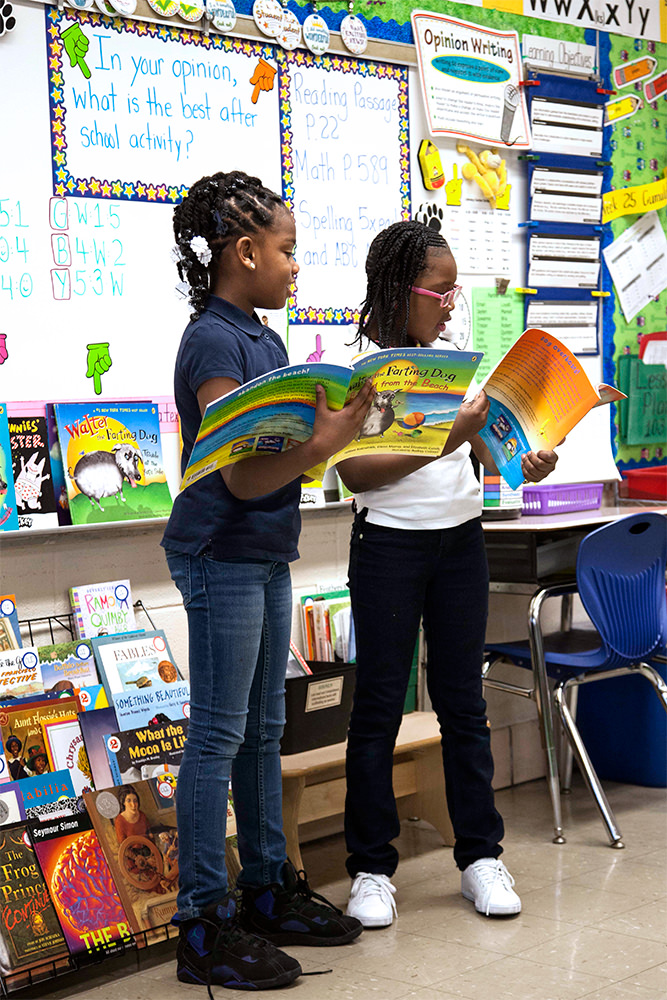Instruction: Share Time
Share time in Reading Workshop is a wonderful opportunity to reinforce the literacy objective from your mini-lesson, provide closure to work time and allow for your children to gather, share, and reflect as a learning community.
Reading Workshop In A Second Grade Classroom - Mini Lesson and Share - Strategy For Determining The Meaning Of Words
Reading Workshop In A Third Grade Classroom - Mini Lesson and Share - Asking Questions To Engage With The Text
Do not underestimate the value of share time! Think of it as wrapping a present. When you put a bow on the present it adds the final touch, making the wrapping complete, and ties everything together. Share time does the same for Reading Workshop as it gives you the chance to literally tie up all the work your children have done together.
Share Time is Valuable
 While share time is usually the smallest amount of time in your workshop, lasting only about five minutes, it can be quite valuable to both you and your children.
While share time is usually the smallest amount of time in your workshop, lasting only about five minutes, it can be quite valuable to both you and your children.
As your children gather at the whole group meeting area for share time (which you will probably do for most share times), they sharpen their speaking and listening abilities. By helping children know their responsibilities and the procedures for share time you can teach social language and cues, build confidence, explore feelings and emotions, and promote effective academic language and communication. Share time facilitates cooperative learning among children. For the child that shares, this opportunity to name the skill or strategy that has helped them means they are more likely to repeat the behavior. Finally, and perhaps most importantly, share time brings closure to the children’s learning.
You can use also share time to acquire valuable information about your children. Take this time to assess what your children have learned or where they still need support. As you listen, use checklists or anecdotal notes to help you in future planning.
What should children be sharing? The following are a few examples.
- How they used a specific reading skill or strategy
- Why they used a specific reading skill or strategy
- New learning from a book
- A connection to the mini-lesson
- Take questions from peers to help solve an issue in their reading
- Make a book recommendation
- Create a visual representation/graphic organizer of the strategy
Different Ways to Share
Share time does not have to be limited to one child sitting in a special chair sharing in front of the group. Get creative as you think about new situations to encourage your children to express their learning and thinking with each other. Try the following ways to share:
Individual Sharing
- Children sit in a circle and one child has the floor. They might pass a special object (like a talking stick) to show who is the speaker.
- Child sits in a chair in front of the group.
Partner Sharing
- Children sit knee to knee, eye to eye, and take turns sharing.
- Partners may be chosen by the children or assigned by the teacher.
Small Groups
- Children sit in small groups of three to five. They take turns sharing.
Speaking and Listening During Share Time
Not only is share time an opportunity for you to assess what children have learned as readers, but it also gives you insight into their speaking and listening behaviors. Your job is to encourage children’s thinking and active listening and develop how they express themselves. Think of yourself as a guide when children need support and provide scaffolds as they grow as speakers and listeners. With intentionally modeled structures, share time can eventually be facilitated by the children themselves.
The following are ideas to support speakers and listeners during share time.
When a child is SPEAKING, try:
Restating what the child says by saying “I heard you say…”
Ask questions to help the child clarify their thinking with “Can you say more about…?”
When a child is hesitant about sharing with the group, try creating a smaller group setting for sharing.
Another option for a reluctant sharer is to gradually release the speaking to them. Use the following frame to encourage the child to participate with you. “I was listening to ______ read and she tried ______. Tell us what happened when you did that!”
When a child is LISTENING, try:
Suggesting questions or help them find the words to express their question or thought.
Teach children to be active listeners and focus on the speaker. Give gentle reminders as to what that looks like and sounds like.
Let the listeners know WHY you chose this child. Give them a task. Tell them, “When ______ is sharing today, I want you to listen to how they ______.” Then, hold them responsible for their listening. Prompt them with, “Tell me how ______ did ______.”
Restate the new learning. Ask the listeners to think about it by saying, “Is this something that could help you in your reading? How? What might you do?”

Comments (27)
Log in to post a comment.